On a clear, quiet Friday morning, February 21st, 2003, around 10 a.m., a tanker barge owned by the Bouchard Transportation Co. was off-loading its cargo of 100,000 barrels of unleaded gasoline at ExxonMobil’s oil depot at Staten Island, New York. Suddenly, an explosion of tremendous force erupted, shaking businesses and homes for miles around (see video at 4th image below). Black smoke from the blaze drifted through the boroughs of Brooklyn, Manhattan, and Queens and rattled terrorist-sensitive city residents, many of whom thought of the 9/11 attack. “I was convinced that there had been a terrorist attack…,” said one woman from Tottenville, Staten Island, three miles south of the blast. “It was so violent. I was in a total panic. You could actually taste the gasoline in your mouth.”
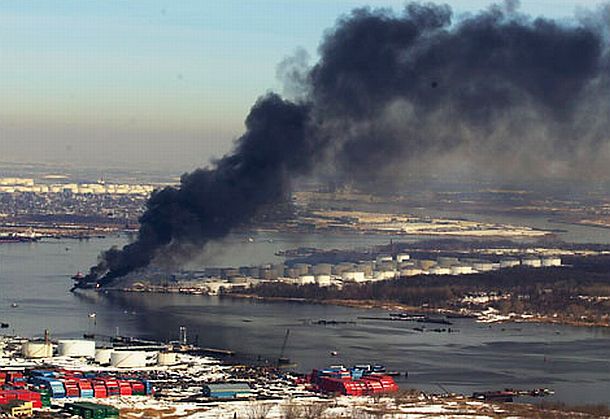
February 2003. A Bouchard Transportation Co. barge exploded & burned while unloading gasoline at the ExxonMobil docks at Port Mobil, Staten Island, NY, on the Arthur Kill waterway. Two workers were killed.
On Wall Street, when traders first heard the news of the explosion, also thinking it was terrorist-related, there was a stock sell-off. But once they learned it was “only a refinery fire,” it was back to business as usual. New York’s mayor at the time, Michael Bloomberg, moved to reassure his city and the nation that there was no reason to believe terrorists were involved.
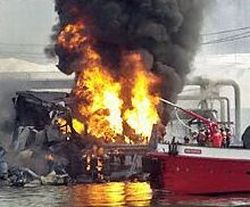 Burning wreckage of Bouchard Barge 125 after Feb 2003 explosion at ExxonMobil oil depot. |
 Map showing location of February 2003 barge explosion & fire in the NY City-NJ area. |
At the accident scene, meanwhile, it was like a war zone. “I looked up at the sky, and I saw pieces of metal flying all over,” said worker Jaime Villa, who was repairing a pump at the depot when the barge exploded. “I ran as fast as I could go…”
Electrical contractor Ernie Camerlingo also described the scene: “It sounded like a bomb going off. I could feel the debris hitting the top of my car….”
Large chunks of the exploding barge – some “as big as a small bus” by one account – flew hundreds of feet away from where the barge was berthed. One New York Times report noted: “Witnesses told of metal chunks flying in the air, of searing heat waves and blast forces that knocked people down, shattered windows and unhinged doors miles away…”
Another account described “chips of burnt material the size of quarters rained down upon the roofs and patios” in residential areas sending “thousands of panicked residents into the streets.”
Bouchard Barge 125 had unloaded about half its cargo of 100,000 barrels of unleaded gasoline before it exploded. It burned ferociously at its depot berth following the explosion, sending flames 100 feet or more into the air. A NASA satellite image later showed the smoke plume stretching about 94 miles from the site of the fire.
Divers who examined the remains of the barge underwater following the incident, found that the explosion had created a tunneling effect, ripping through the vessel and destroying all 12 of its cargo tanks. A malfunctioning pump aboard the barge was later suspected as the culprit, possibly discharging sparks that ignited the explosion (play silent video below briefly to see size of initial explosion).
As the barge burned that day the New York City Fire Department sent fire boats and fire trucks to the scene. The boats battled the blaze from the Arthur Kill side of the incident, while fire trucks went to the depot side to fight the fire from land.
At one point another tanker barge, Bouchard Barge 35, also loaded with 8,000 barrels of gasoline, began burning. That fire was put out before it could ignite another explosion, but the barge was still near the blazing inferno. Heroically, one tug crew went in there and pulled the threatened barge away from the blast area. It was then doused with water by the fire boats to keep it cool.
The 200-acre storage depot, meanwhile, which included eight loading berths and 39 large storage tanks, was also a major concern. Residents living near the industrial area were evacuated after the explosion. The depot’s storage tanks could hold up to 2.5 million barrels of gasoline, low-sulfur diesel and jet fuel. But at the time, less than 500,000 gallons of product were then in storage at the depot.
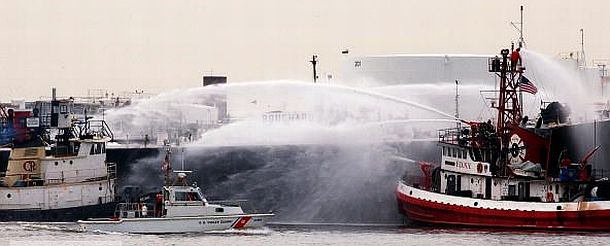
After being pulled from near the explosion area, fire boats proceeded to douse Bouchard Barge 35 with cool water, at it was also loaded with gasoline and fire officials feared it too would explode.
At the time of the explosion, there were about 30 ExxonMobil employees on the job at the depot. One ExxonMobil worker at the dock was severely burned and hospitalized, while the bodies of two Bouchard barge crewman who were killed in the explosion were later pulled from the water. Firefighters had contained the barge blaze by the afternoon of the explosion, but flickering flames could still be seen at the site the following morning.Another Bouchard barge spill of 98,000 gallons of oil in Buzzards Bay, Mass. killed hundreds of loons, sea ducks and other birds. The Coast Guard closed the Arthur Kill waterway to shipping between Staten Island and New Jersey. The barge remained partially submerged, and eventually sunk.
The Bouchard Transportation Co., meanwhile, had some previous New York spills, one East River spill in March 2002 in which a Bouchard employee was found legally drunk. The cleanup for that spill lasted several weeks and cost $1.3 million. Bouchard would also have another spill a few months following the Staten Island barge explosion, when one of its barges in April 2003 ran aground outside a shipping lane at Buzzards Bay, Massachusetts. In that spill, 98,000 gallons of No. 6 fuel oil took a considerable toll on birds and other wildlife. Hundreds of loons, sea ducks and other birds were killed. Beaches there, which serve as key habitats for birds such as piping plovers, were also oiled. Bouchard would pay a $10 million fine as part of a criminal plea deal in that case, the government charging the company had negligently piloted the barge, resulting in the death of migratory birds in violation of the Federal Migratory Bird Act. In November 2010, Bouchard also agreed to pay another $6 million penalty in that case to settle claims for water pollution.

Smoldering remains and aftermath of the Bouchard Barge 125 explosion at ExxonMobil’s Staten Island depot. Half-sunken remains of the barge visible in the foreground, as large portions of it were blown out into the depot.
|
“The Daily Damage” This article is one in an occasional series of stories at this website that feature the ongoing environmental and societal impacts of industrial spills & explosions, fires & toxic releases, air & water pollution, and other such occurrences. These stories will cover both recent incidents and those from history that have left a mark either nationally or locally; have generated controversy in some way; have brought about governmental inquiries or political activity; and generally have taken a toll on the environment, worker health and safety, and/or local communities. My purpose for including such stories at this website is simply to drive home the continuing and chronic nature of these occurrences through history, and hopefully contribute to public education about them so that improvements in law, regulation, and industry practice will be made, yielding safer alternatives in the future. |
Back in New York, in November 2008, three years after the Staten Island barge explosion, the U.S. attorney’s office in Brooklyn asked a federal judge for a judgment against Bouchard of up to $61.6 million under the Clean Water Act. Some 3.2 million gallons of gasoline spilled into the Arthur Kill waterway at the time of the incident, much of which was assumed to have been burned off in the fire that followed. Still, under the Clean Water Act penalties of up to $1,100 per barrel of spilled oil can be sought. “Shipping companies that spill large quantities of gasoline into the environment and navigable waters must be penalized and made to contribute to the cost of future cleanups,” said U.S. attorney, Benton J. Campbell, in a statement at the filing.
The final outcome of that case, however, did not come until February 2011, eight years after the explosion, when Bouchard agreed to pay $4 million to settle the Clean Water Act lawsuit for the 50,000 barrels of gasoline it allegedly spilled near Staten Island, N.Y. The civil penalty was then the largest ever collected by the Coast Guard in a federal Clean Water Act case, according to Loretta Lynch, U. S. Attorney for the Eastern District of New York and Admiral Daniel Neptun, Commander of the First Coast Guard District. Still, the Coast Guard, had originally sought a penalty of up to $1,100 per each barrel of oil spilled, which would have amounted to more than $50 million.
See also at this website, for example: “Burning Philadelphia,” a story about the 1975 Gulf Oil Co. refinery fire in that city; “Burn On, Big River,” about the historic pollution of the Cuyahoga River in Ohio; or “Inferno at Whiting,” about the Standard Oil refinery explosion and fire of August 1955 near Chicago that burned for eight days. Additional environmental stories can be found at the “Environmental History” topics page. Thanks for visiting – and if you like what you find here, please make a donation to help support the research and writing at this website. Thank you. – Jack Doyle
|
Please Support Thank You |
____________________________________
Date Posted: 17 September 2015
Last Update: 23 March 2019
Comments to: jdoyle@pophistorydig.com
Article Citation:
Jack Doyle, “Barge Explodes in NY, ExxonMobil Depot: 2003”
PopHistoryDig.com, September 17, 2015.
____________________________________
Sources, Links & Additional Information
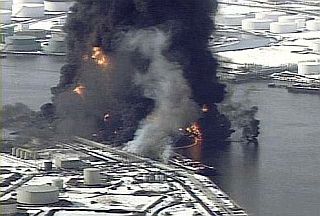 One fear at the time of the February 2003 barge explosion was the possibility of a storage-tank chain reaction at the depot. |
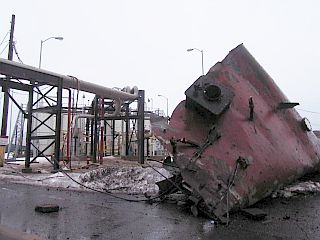 “Vehicle-size” piece of the exploding Bouchard Barge 125 that was hurled into the depot on February 21, 2003. |
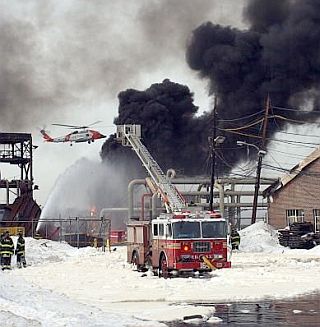 Part of the “depot side” firefighting contingent that fought the 2003 Staten Island barge explosion & fire. |
CNN, New York, “Two Bodies Recovered after Barge Explosion; Flames Shoot Hundreds of Feet Over Staten Island,” CNN.com, Friday, February 21, 2003
Brooke A. Masters, “Explosion Rocks Staten Island Oil Facility; No Indication of Terrorism, Authorities Say,” Wash- ington Post, Friday, February 21, 2003.
Robert D. Mcfadden, “Oil Barge Blast in Staten Island Leaves 2 Dead,” New York Times, February 22, 2003.
Robert D. McFadden, “The Barge Blast: The Overview,” New York Times, February 22, 2003, p. B-1.
Andrew Jacobs, “The Barge Blast: Jitters,” New York Times, February 22, 2003, p. B-7.
Elissa Gootman, “2 Who Died in Barge Blast Understood Job Risks, But Liked the Benefits,” New York Times, February 24, 2003
“Two Killed in Explosion of Gasoline Barge in New York Harbor,” Pro- fessional Mariner (Journal of The Maritime Industry), June/July 2003.
“Oil Spill Closes Bay To Shellfishing; Wildlife Officials Trying To Save Birds,” TheBostonChannel.com (re: Bouchard grounding & spill in Buzzards Bay, MA), April 29, 2003.
Andy Newman, “U.S. Sues Barge Operator in Fatal 2003 Explosion,” New York Times, November 6, 2008.
Bill Brucato, “Explosion at Port Mobil Staten Island NY, 10:00 am February 21, 2003. The Bouchard 125,” YouTube.com (run time, 9:15), uploaded on February 4, 2009.
captbbrucato, “The Bouchard 125, Port Mobil Explosion,” NY Tugmaster’s Weblog, February 5, 2009.
Richard Vanderford, “Bouchard To Pay $4M Over NY Gas Spill,” Law360.com, February 8, 2011.
“Environmental Enforcement: $4 Million Penalty Imposed in 2003 Staten Island Barge Explosion,” EnvironmentalLeader .com, February 10, 2011.
“Assault on America: A Decade of Petroleum Company Disaster, Pollution, and Profit,” National Wildlife Feder- ation, Washington, D.C., June 2010, 32pp.
___________________________